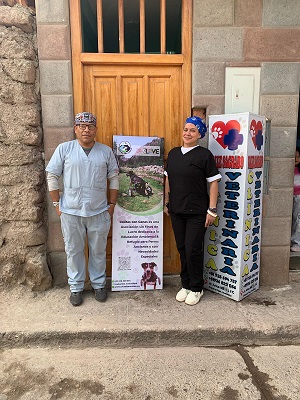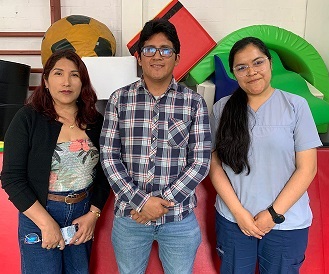Veterinarian Joel Campana has saved the lives of many dogs, cats, and other animals that have come to the Valle Sagrado clinic in Urubamba, Cusco, Peru. Together with 3Love Inc. and Colitas con canas, Dr. Campana has carried out several sterilization campaigns over the past year. In this exclusive interview for our blog, we talk to him about the benefits of sterilizing dogs and cats, both for the animals themselves and for the community, as well as the importance of educational campaigns.
Why is it important to run educational and awareness campaigns about animals?
I would love to change children’s mindsets, because parents respect children, and it’s nice when they teach you things. Whenever we run campaigns, we teach people about responsible pet ownership and how it is linked to public health. It is directly related, because we have animals that are in our homes 24 hours a day, they play with us, they often sleep with us, and we share the same parasites. And zoonosis is one of the leading transmissible diseases. Some time ago in Pumamarca, we ran a deworming campaign. We contacted the health center and, at the same time as we dewormed the animals, we also dewormed the children. Anemia rates dropped just by doing that. So, people need to understand the importance of this and the benefits it brings, not only to the individual, but also to the family and the world. The three things go hand in hand, because a person who is sensitive to animals is sensitive to the environment and society, and is a collaborator. What we need to change in our society are aggressive people. We can do that by educating people. And there is nothing more important than education. I have a lot of experience in this and have worked with NGOs that ran many campaigns, but if we don’t educate, the families we had already helped with sterilization would adopt another animal or buy a puppy. The basis of everything is education. If we don’t educate, we lose. For example, we will soon return to Ollantaytambo to work with a school, precisely to talk about responsible pet ownership, because the idea is to teach, to change people’s future. The future will improve if we change their way of thinking, and they will have a slightly more peaceful life. There was a study conducted in a prison, and 80% of the inmates had been animal abusers since childhood. That’s a very high percentage. So, we also have a scientific basis for asserting that this change will help us socially.
What are the benefits of sterilization campaigns for dogs and cats for the animals themselves?
In terms of health, there are two categories: females and males. As for females, there are pathologies specific to the species. When we sterilize a female dog, for example, there are benefits in terms of both pathologies and reproductive tract diseases. In the case of female cats, they go into heat when stimulated, have a litter, and will have another one as soon as they stop nursing, because they see a male cat, are stimulated, and will go into heat again. This is unlike dogs, which have a specific time when they go into heat, on average every eight months. So, in terms of health, this helps them a lot. As for breastfeeding, there are reproductive pathologies: mastitis, mammary tumors, breast cancer. We can eliminate all these pathologies in females with a simple step, which is sterilization. As for males, sterilization prevents aggression, fighting, territoriality, the spread of rabies, and the transmission of various diseases and pathologies, as well as the fact that male dogs tend to be stray dogs. These are the benefits of sterilization. With one surgery, we can reduce all of these issues in an animal.
On the other hand, how does the community benefit from sterilization campaigns in terms of health and disease control?
The fact that dogs will not be wandering around or gathering in one place. Research has been conducted at the National University of San Agustín in Arequipa (UNSA), where feces and fecal material from animals in parks and gardens were collected. It was found that the parasite load was extremely high. Normally, people go and sit in a garden to relax or eat there. So, the fact is that we are going to reduce both the animal population through sterilization and the stray animal population, but we are also going to reduce zoonotic diseases, which are parasitic diseases such as tapeworms, worms, or even rabies. These are the benefits we are going to achieve with sterilization.
One of the major problems observed in several countries around the world, especially in Latin America, is animal abandonment. How can this problem be addressed?
The first step is education. But legislation must also play a role, with regulations to ensure that policies and clauses are in place to protect both citizens and animals. The purpose of establishing a rule is not only to punish those who are acting wrongly, but also to benefit those who are acting correctly, or us, who live in this society. The problem is that sometimes very drastic and harsh measures are taken against the most defenseless, which is the animal, such as capture and euthanasia, but no penalty is imposed on the owner of the animal. As long as we only punish the weakest, we will all lose. If we are talking about an insensitive society, they don’t care if their dog is killed, they will get another one, because they do not receive any kind of fine or penalty for their wrongdoing. But if we work in both ways, educating and imposing penalties, we will make a change. Right now, the regulations we have are against the weakest. For me, we need to educate and implement government policies that help us punish those who should be punished, which are the owners.
What is the greatest personal satisfaction you get from working with and treating animals?
First, you have to prepare yourself to be able to care for them. If you don’t feel ready, keep studying. When you feel ready, you have to get out there and do it. You can do anything with the animals in the clinic and they will never complain. They will be afraid of you, and when you see that your four-legged friend is afraid of their veterinarian, be careful. The greatest satisfaction for me is being able to take a patient who is on the verge of death and bring them back from the brink and give them life. I love that. It’s a great responsibility, but also a great satisfaction to be able to make decisions about life and death. And just as it’s a great responsibility, you also have to know how to take it on.


